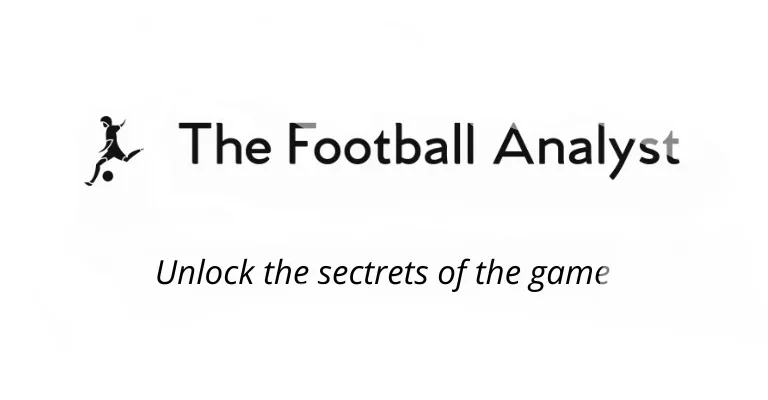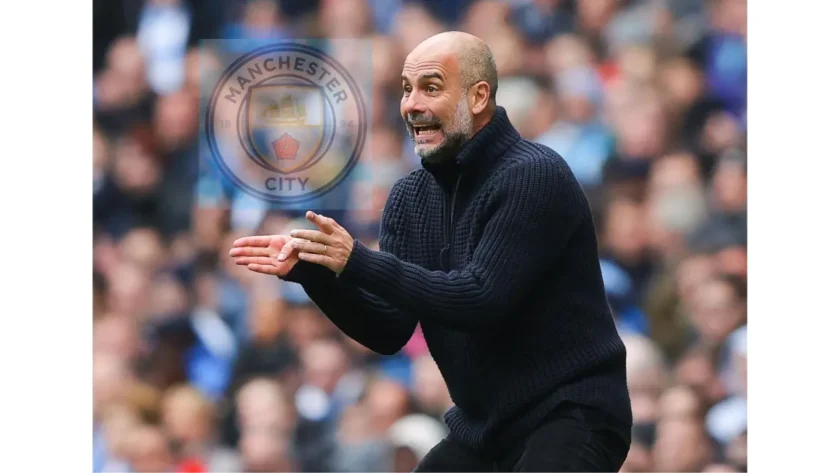In the realm of football management, few names command as much respect and admiration as Pep Guardiola. His tenure at Manchester City has revolutionized football, transforming the club into a powerhouse known for its intricate playing style and tactical brilliance. This article dissects the tactical nuances that define Pep Guardiola’s approach at Manchester City. From his distinctive formations to strategic player movements, we delve into the intricacies that have shaped City into a formidable force under his guidance. Join us on a journey through the tactical realm of Pep Guardiola and Manchester City in this comprehensive analysis.
Build-up
Low Build-up
In the low build-up, Pep Guardiola sets his team up in a 4-2-5 formation, with the goalkeeper playing between the center-backs and a box-midfield in the middle.
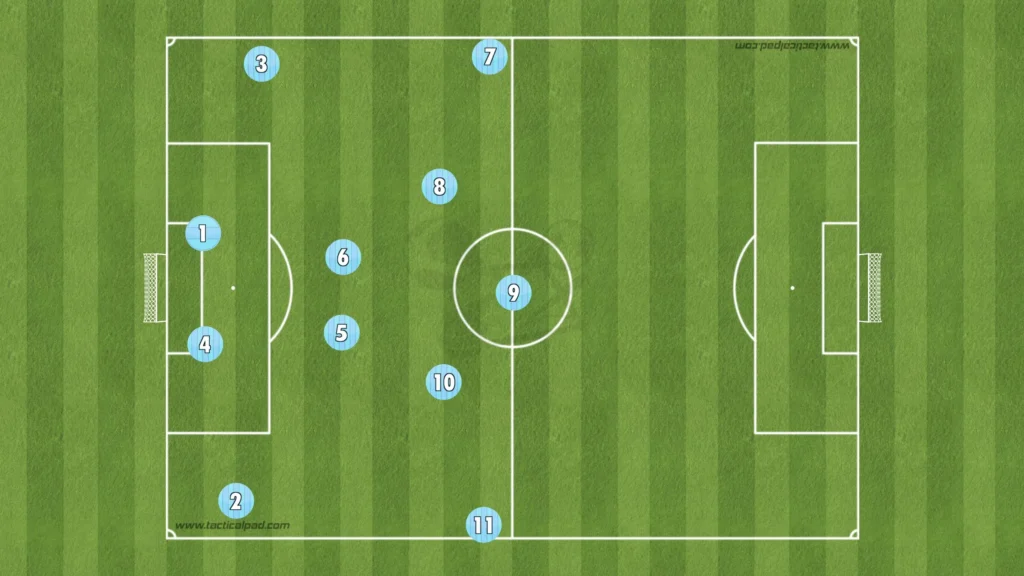
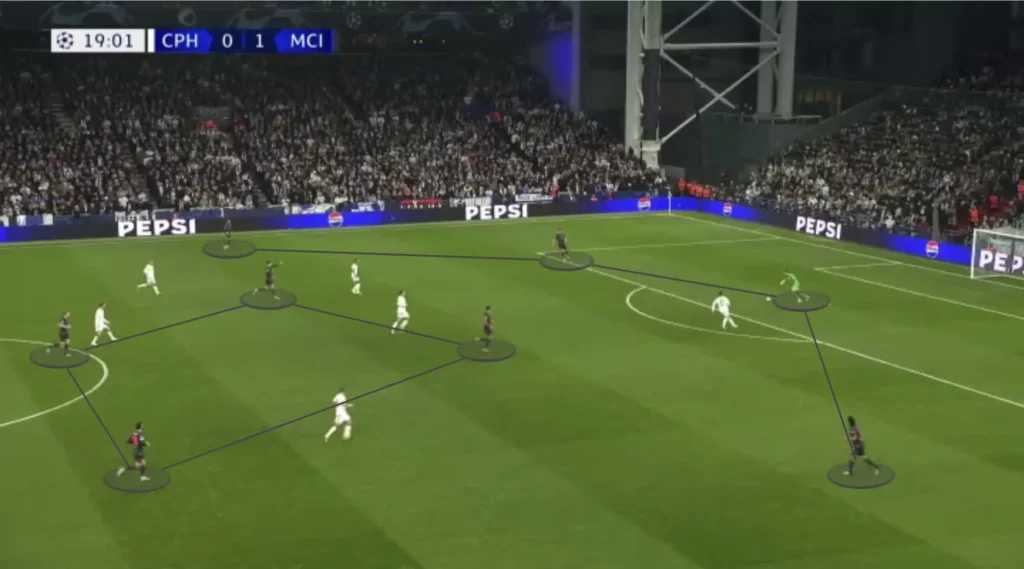
They often drop with the attacking midfielders and like using the goalkeeper, which creates numerical superiorities, allowing them to beat the press.
Inverting the Fullback or Center-back
Pep Guardiola uses a four-back in defense but a three-back in attack, which means that one defender needs to push up as a winger or invert into the midfield during the build-up. This creates more options in the center and less space between the players. Pep likes this because he prioritizes playing through the middle. He needs one player high and wide to pull apart the backline while the rest create numerical advantages in the midfield areas. This builds good conditions in defensive transitions, allowing more players to press when they lose the ball. Another purpose for keeping many players in the middle is to shorten the distance between them. This shortens the length of the passes, which naturally shortens the time between passes. This means the opposition players will have less time to push up and press, giving the City players more time and control.
John Stones has frequently been used as this inverting player and is usually a center-back in defense and a holding midfielder in attack. Pep has also used fullbacks like Rico Lewis and other center-backs like Manuel Akanji in a similar way.
High Build-up
In the high build-up, Pep Guardiola’s Man City set up in a 1-3-2-5 formation, the same as in the low build-up without the goalkeeper between the center-backs:
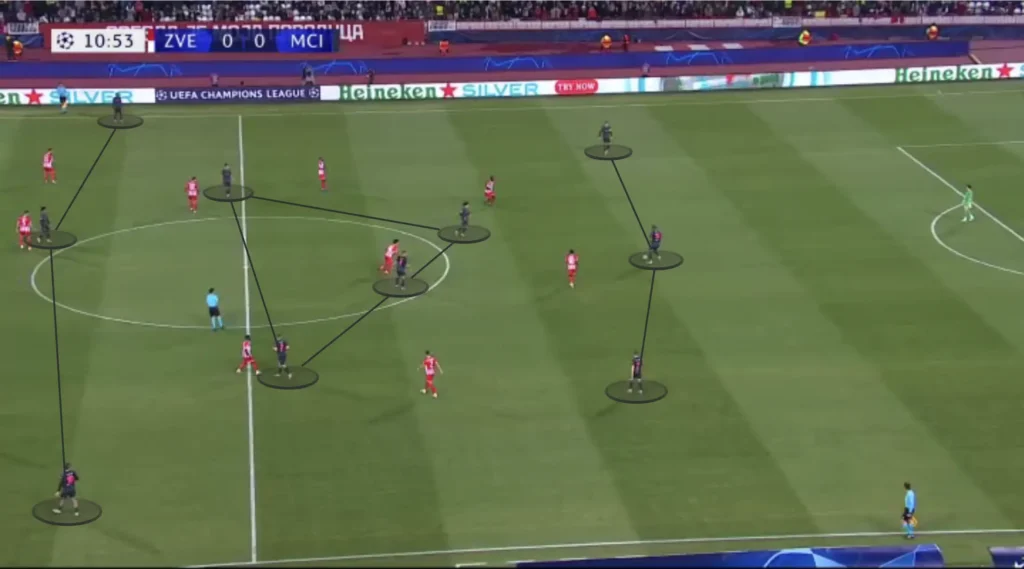
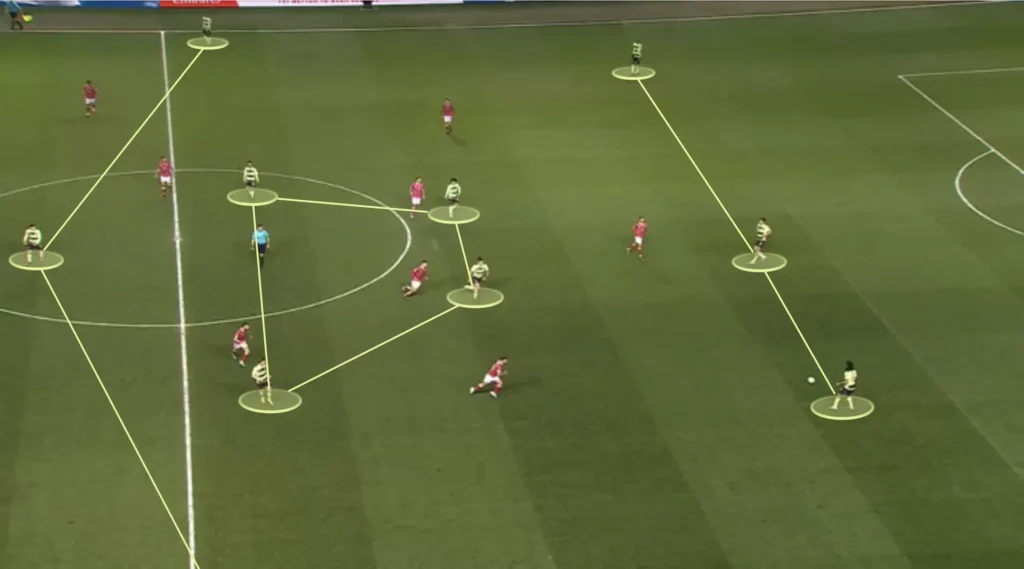
The two Holding midfielders are rarely positioned in the same line. One will always be a little deeper, but who it is depends on where the ball is.
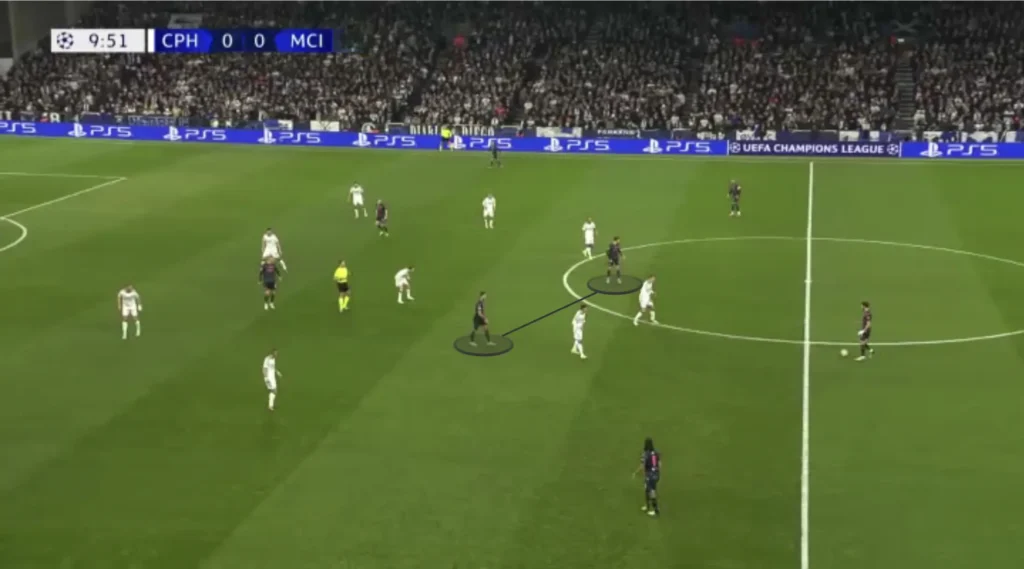
This allows the holding midfielders to play between themselves and opens up more potential passing combinations. They can also use one touch to play to the other midfielder instead of turning and using two or more.
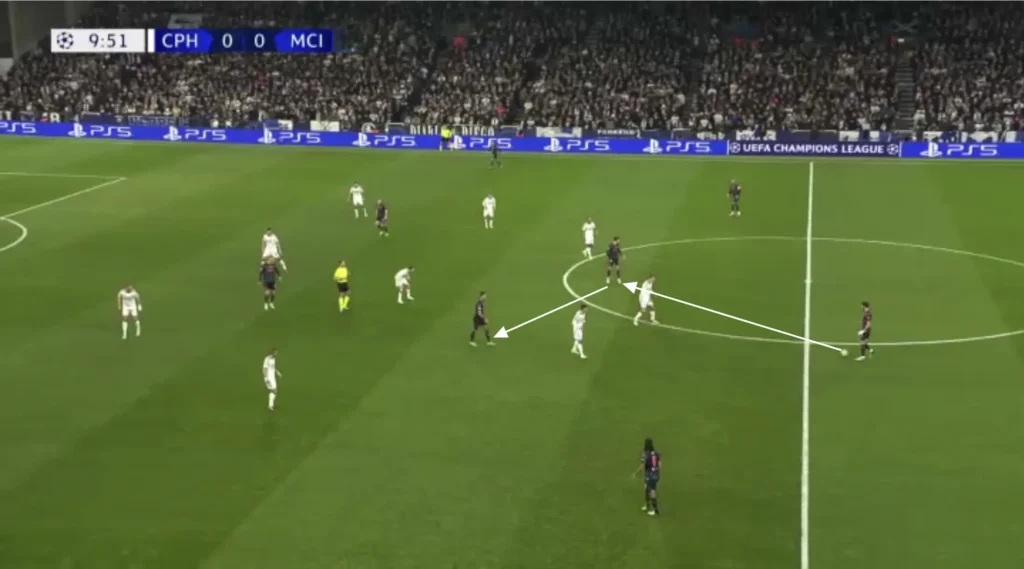
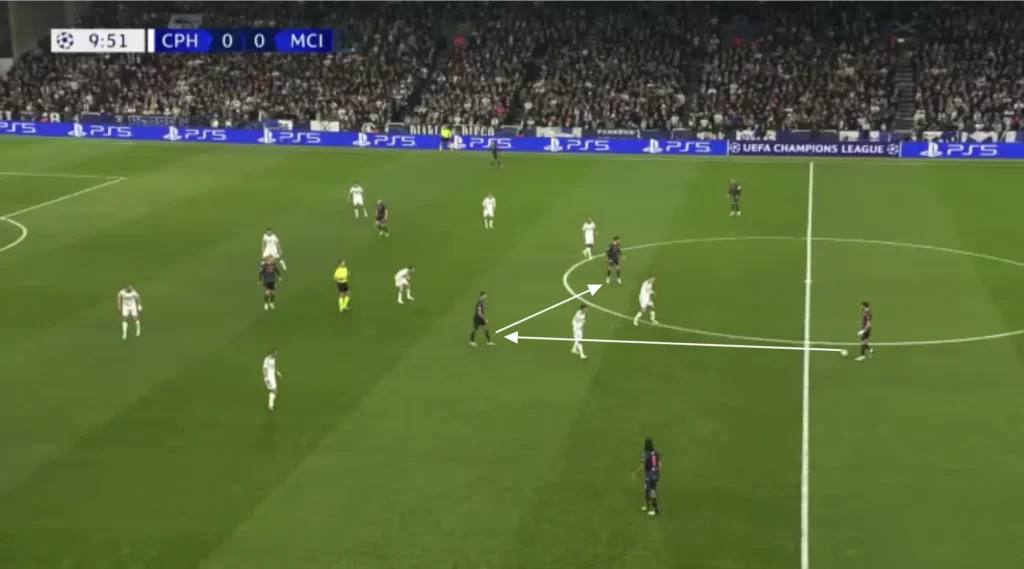
High Backline
A massive aspect of City’s high possession build-up is they keep a high backline. This helps in the counter-press because they get closer to the center. Having more players close to the center who can win the ball back makes it difficult for the opposition to recycle possession. Furthermore, the high backline shortens the distance between players, shortening the time and length of the passes and preventing the opposition from pushing up their defense.
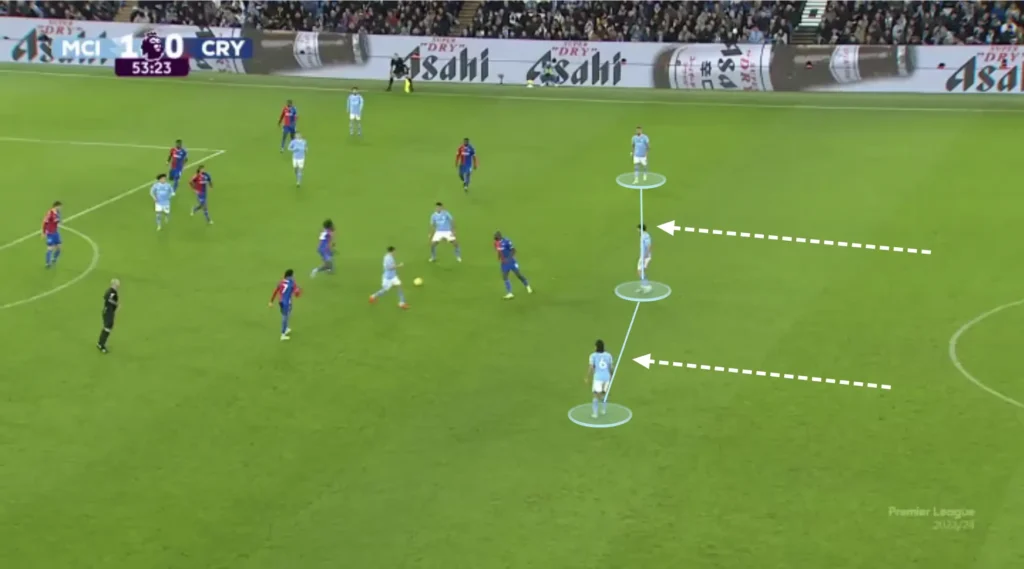
Changing Formation
Man City, however, often rotates in their build-up, creating new formations to confuse opponents. They also adapt to their opponent’s formation to create numerical advantages in different areas, allowing them to beat the defense and score more goals. Their most frequent formation change is to push one of the center-backs into the midfield, creating a 1-2-3-4-1 formation. Their principles and general guidelines stay the same when they do this.
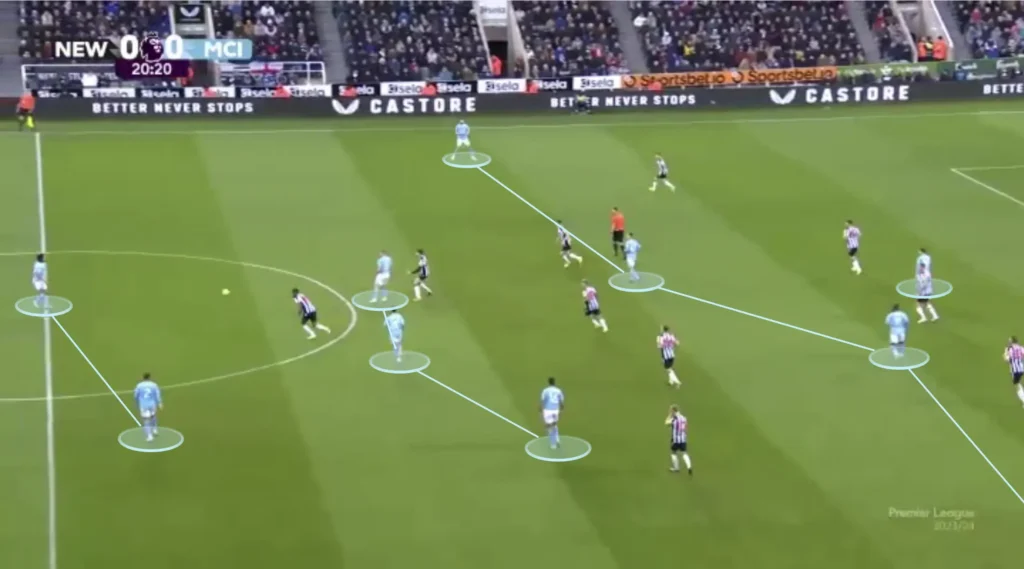
Linking with the Striker
Pep Guardiola likes to create central overloads when attacking the opposition. Many opponents, therefore, defend with four midfield players to neutralize City’s box-midfield. Pep’s answer to this is often to drop with the striker(Haaland). When the striker drops, they again become numerically superior in the midfield, allowing them to beat the opponent’s defense. If the center-back pushes up on the striker, Man City will exploit the space in behind.
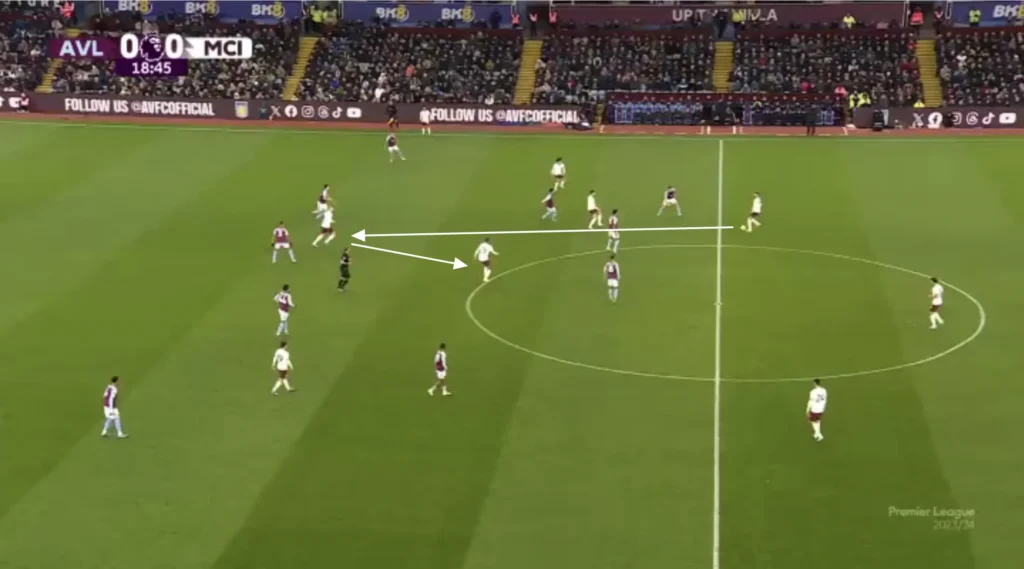
Finding the Pockets
Man City always try to find the attacking midfielders in the pockets. City’s midfield numerical superiority usually means that at least one will be open. They will look for passes from the back or the wing, breaking lines and finding an attacking midfielder who will turn and drive at the defense.
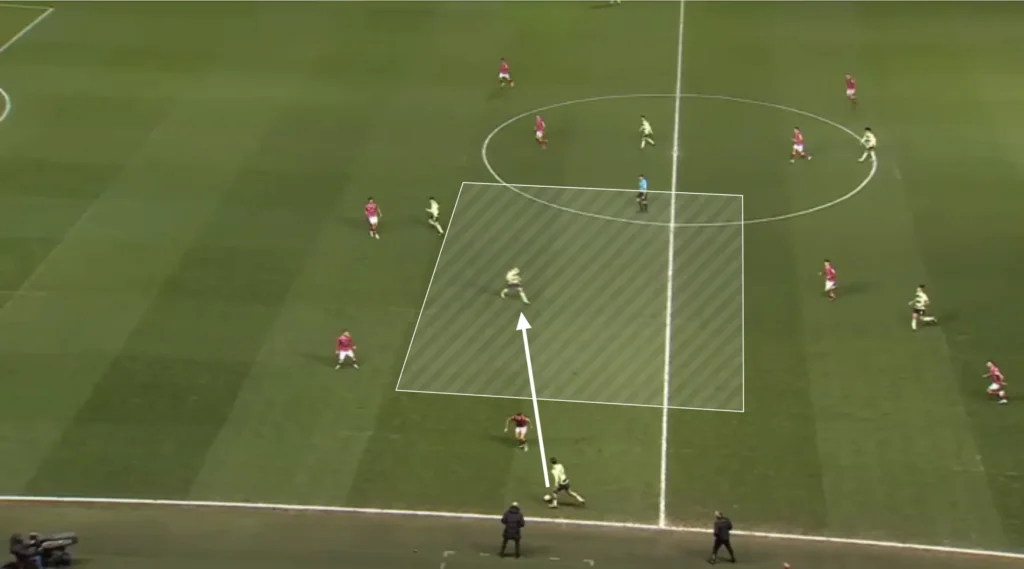
Final Third
Attacking the Half-Space
Manchester City is an excellent team in the final third. They will always create many chances, mainly by attacking the space between the opposition center-back and fullback.
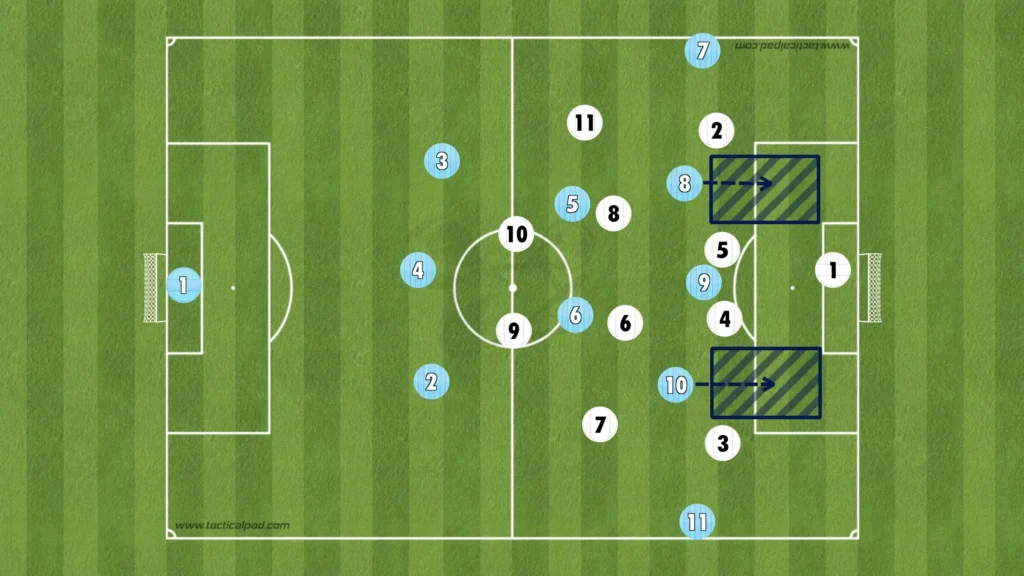
One way they do this is by using an underlap. Man City will often, through their possession, find space for their wingers after a switching play with a long ball. The winger will then attack his fullback, waiting for the run from the number-eight.
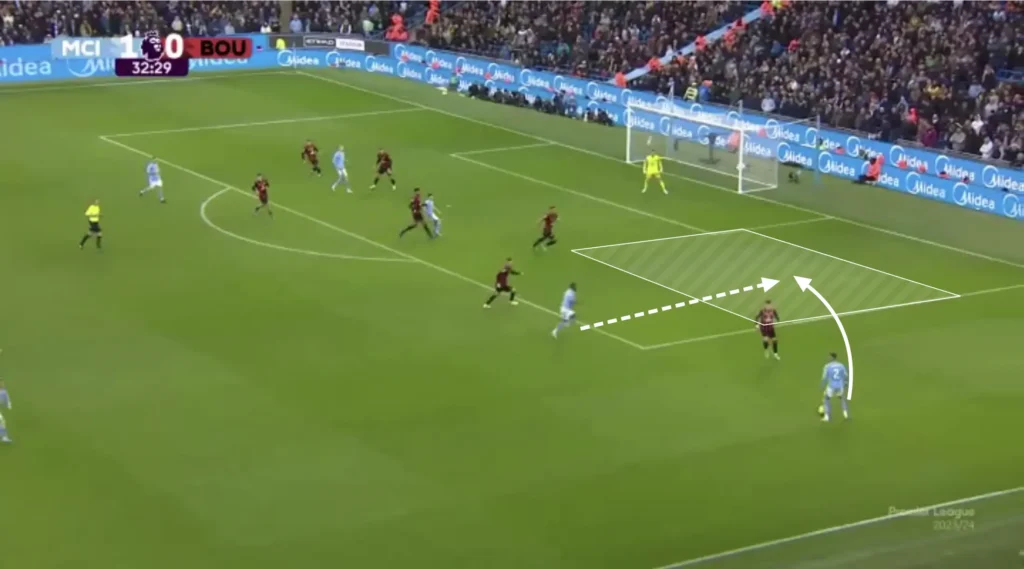
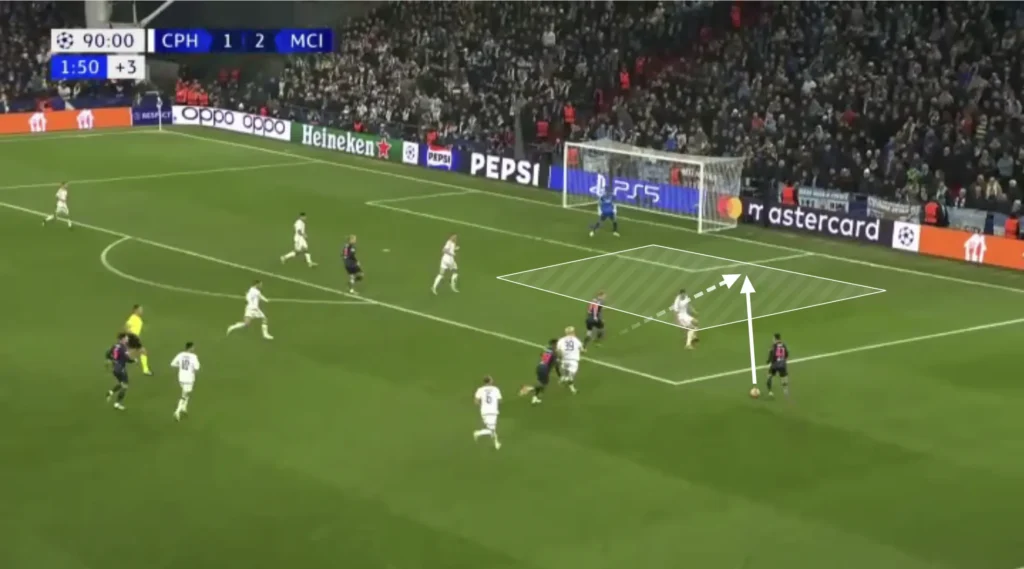
The defending midfielder, who is responsible for the Man City attacking midfielder, often struggles to track the run, which forces the center-back to make a decision. If he goes to track the run, he leaves a massive space in the box for the striker to exploit. Therefore, many center-backs will stay in the center, allowing the winger to play the ball into the open space to the free number-eight.


An interesting detail about the underlap is that the City players often make the underlapping run very close to the fullback. The objective of the underlap is to create as big a question as possible for the center-back. If the runner makes the run close to the center-back, the center-back does not have to leave his position much to defend the underlap, which allows him to protect the space in the box and defend the underlap. However, if the runner, like De Bruyne does in this case, runs close to the fullback, the center-back has to leave his position much more to defend the underlap, which opens the space inside. They question whether the center-back should stay in his position or track the run, therefore, becomes way bigger if the underlap is made close to the fullback.
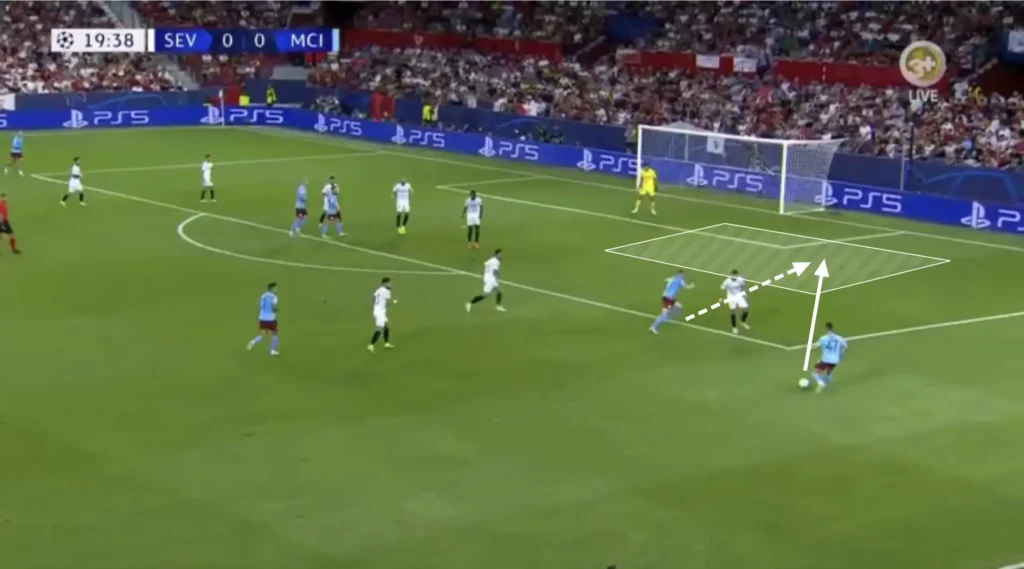
Taking it Inside
The winger, however, does not have to play the ball to the underlapping player. The underlapping player will often drag away a defensive midfielder, which opens the space inside. The winger can take the ball inside and shoot or find a pass to a free player in front of the backline. Here, the space in front of the backline opens up because the defensive midfielder leaves his position to track the underlapping run. The ball is played to the free player, who can shoot and score.
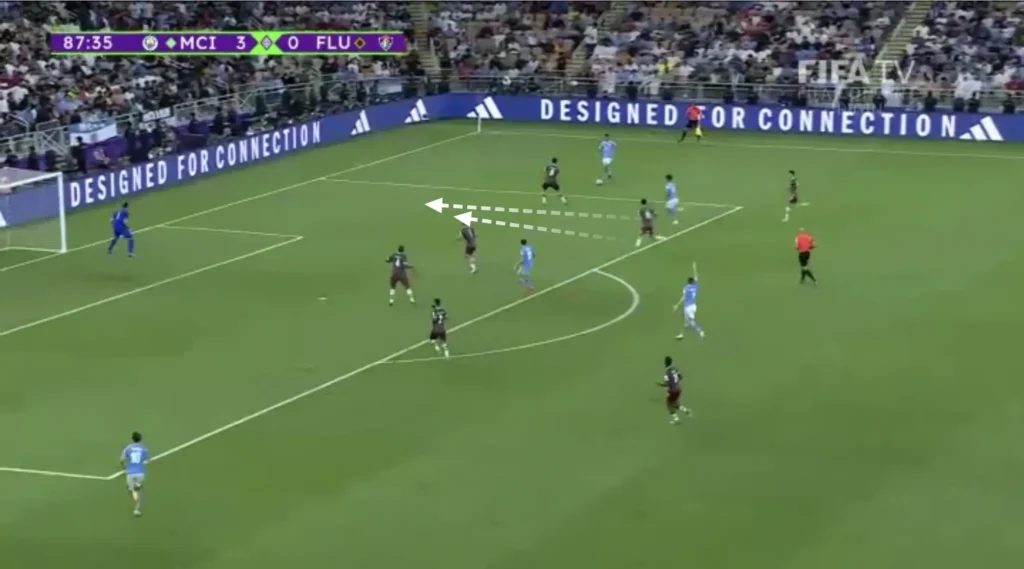
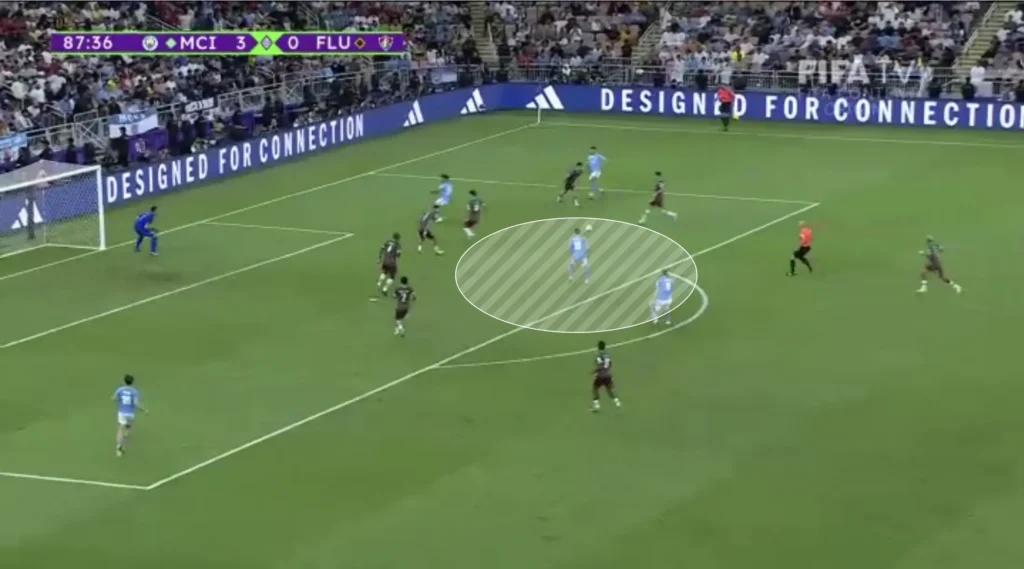
Pep Guardiola’s team also exploits the space between the center-back and the fullback by playing through-balls from the midfield or backline.
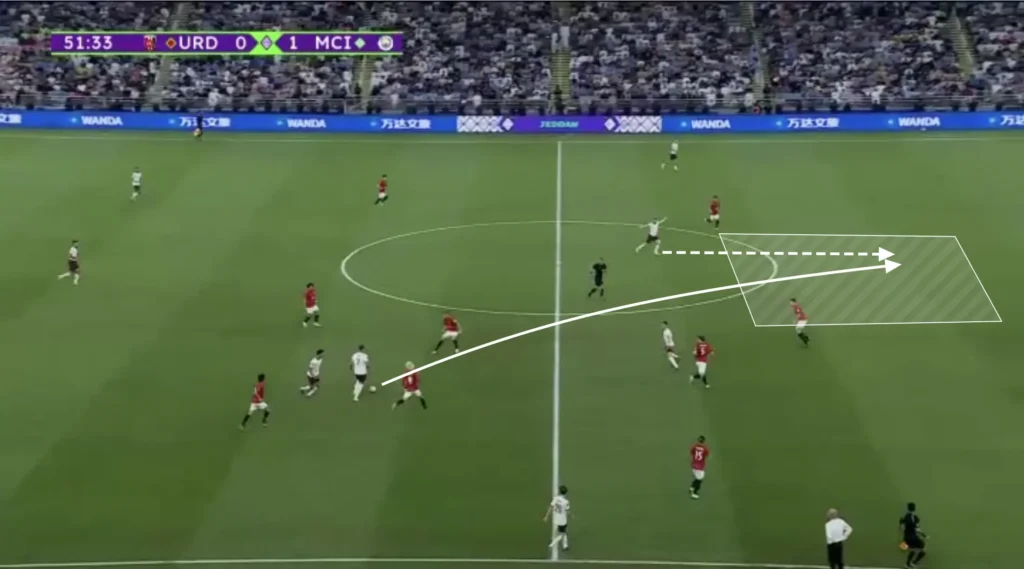
Overlaps
Manchester City also uses the overlap to produce opportunities in the final third. When the winger gets the ball, a City player quickly makes the overlap, creating a 2v1 on the wing. If the opposition fullback drops to cover the overlapping run, the winger could cut inside, taking a shot or combining with a midfielder. If the fullback covers the center, the ball can easily be played to the overlapping player, creating a crossing opportunity.
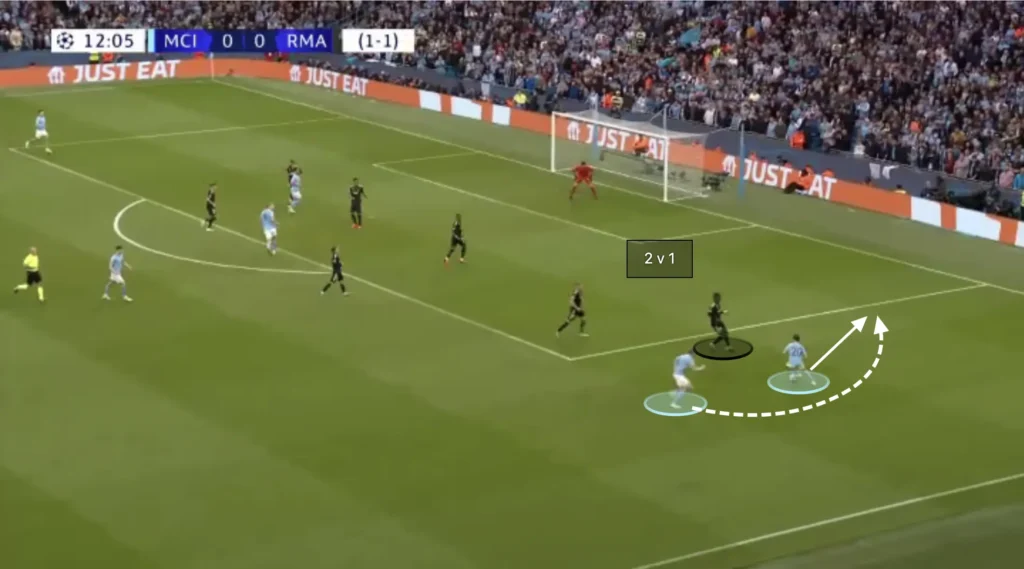
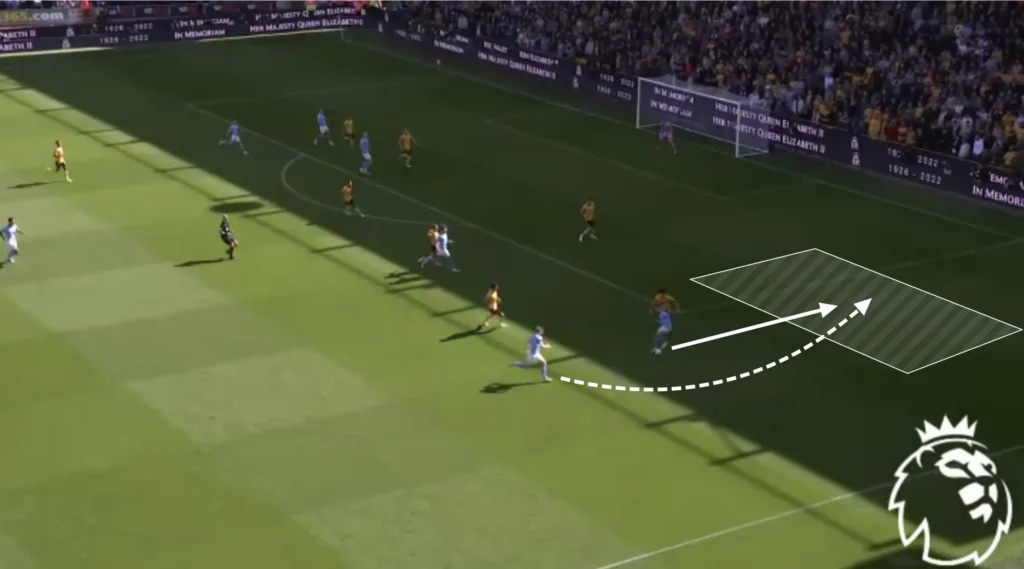
Many Players in the Box
The attacking midfielders also look to make runs into the box when the ball is in the final third, often getting four or five players into these areas to create overloads. The numerical advantages in the box force the defending team to make decisions and leave some players open.
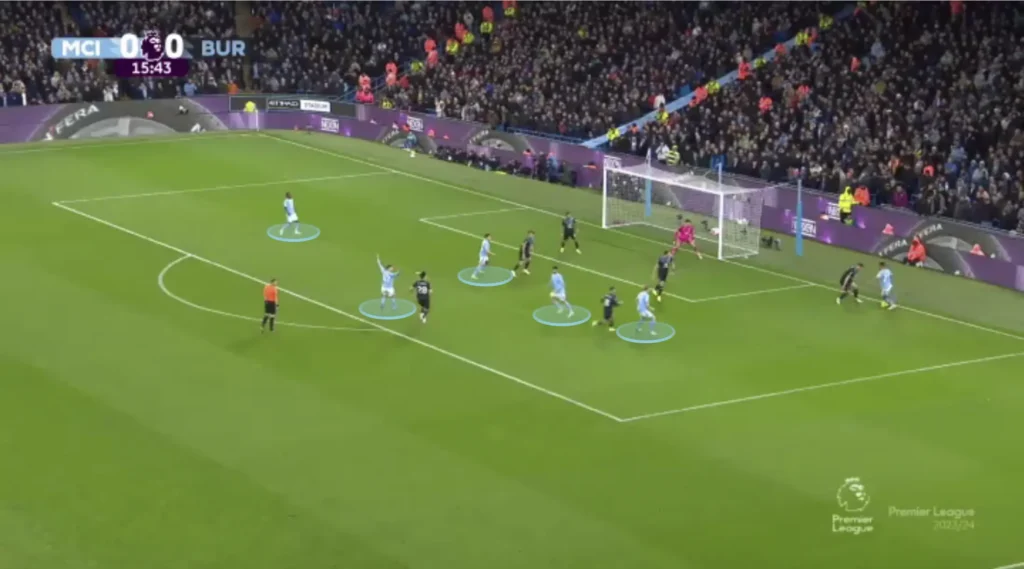
Pep Guardiola positions many Man City players outside the box, ready for the second balls and cut-backs as well. They always succeed in pushing down the opposition’s defense, which opens the space in front of the backline. Man City often finds players like De Bruyne or Bernardo Silva in these spaces who can shoot or combine with an attacker to create goalscoring opportunities.
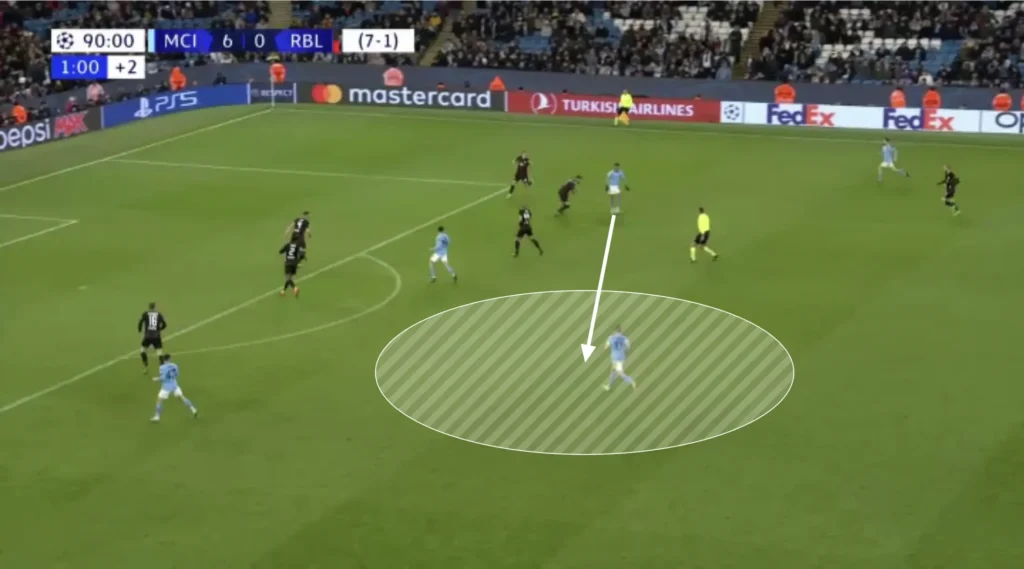
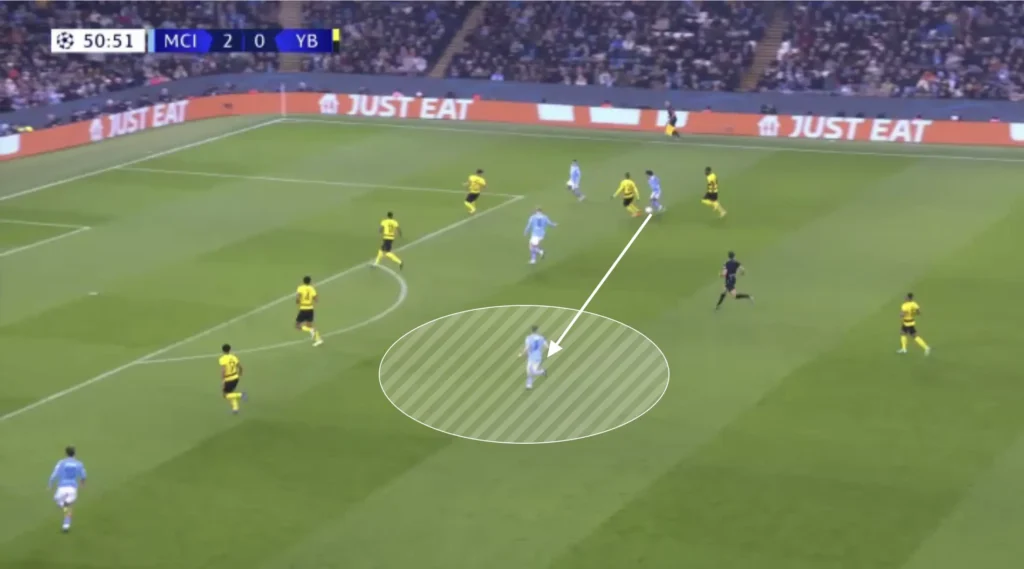
Back Post
Man City score many of their goals from crosses where they run at the back post. Staying on the blindside of defenders makes it difficult for them to know exactly where you are while you know exactly where they are. The City attackers, therefore, often position themselves at the back post in crossing situations to have complete control of their defender. The back post is where the space is, and the center-back’s lack of vision often makes it uncontested. In addition, the player defending that area is usually the fullback, who presumably will be a weaker aerial defender than the center-backs. Haaland is the master of the back post, scoring most of his goals from there.
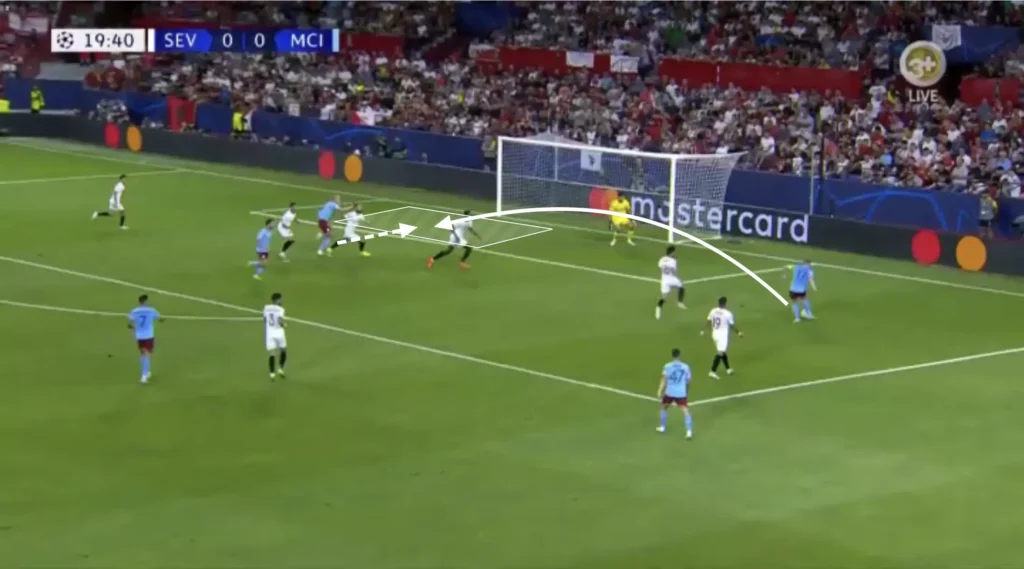
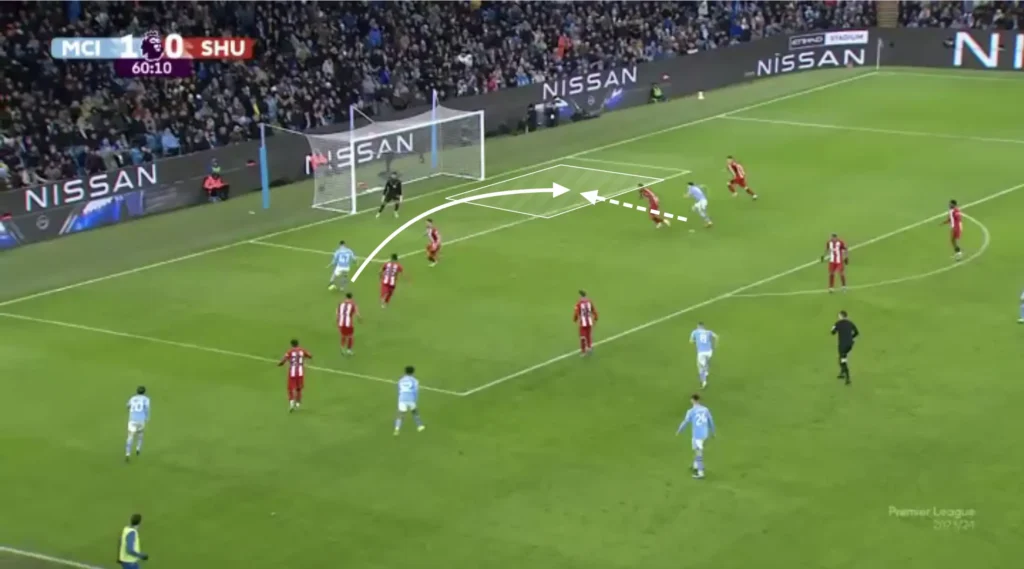
Principles and Tools
Keeping Possession
Pep Guardiola’s Manchester City exemplifies a possession-oriented style of play that is both mesmerizing and effective. The team’s commitment to ball retention is evident in their meticulous build-up from the back, involving the goalkeeper and center-backs circulating the ball with short, purposeful passes. The emphasis on players’ positioning and movement creates passing triangles, offering multiple options and ensuring constant ball circulation. Guardiola’s City patiently breaks down defenses, looking for the optimal moment to unlock opposition lines. This possession-focused approach controls the game’s rhythm while wearing the opponents down, giving Guardiola’s team more energy later in games.
Third-man
Pep Guardiola, as established, likes it when his team plays through the opposition when possible. One vital tool that they often use is the third-man principle. This means using a third player to reach a free player whose passing lane is blocked.
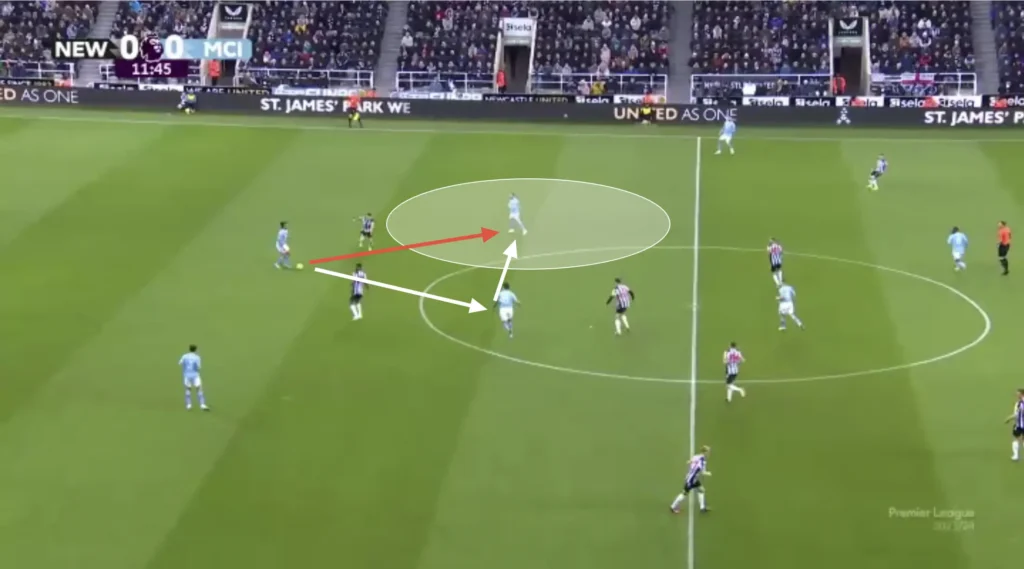
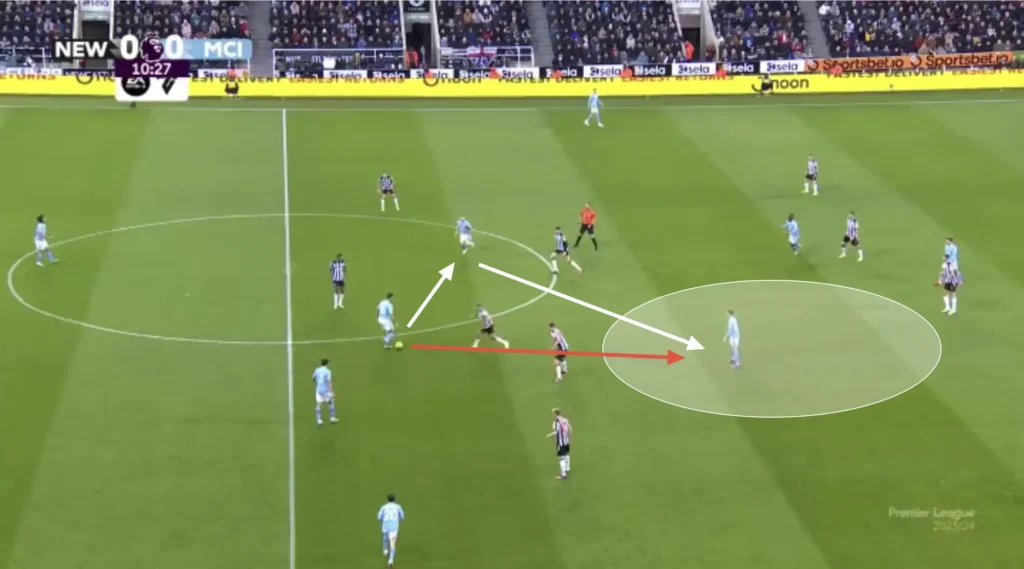
Bounce-pass
They also use bounce-passes to attract the opposition and open up their defense. A bounce-pass means passing the ball back and forth to make the opposition players push up and press. Here, Real Madrid defends compactly, closing the space in the center.
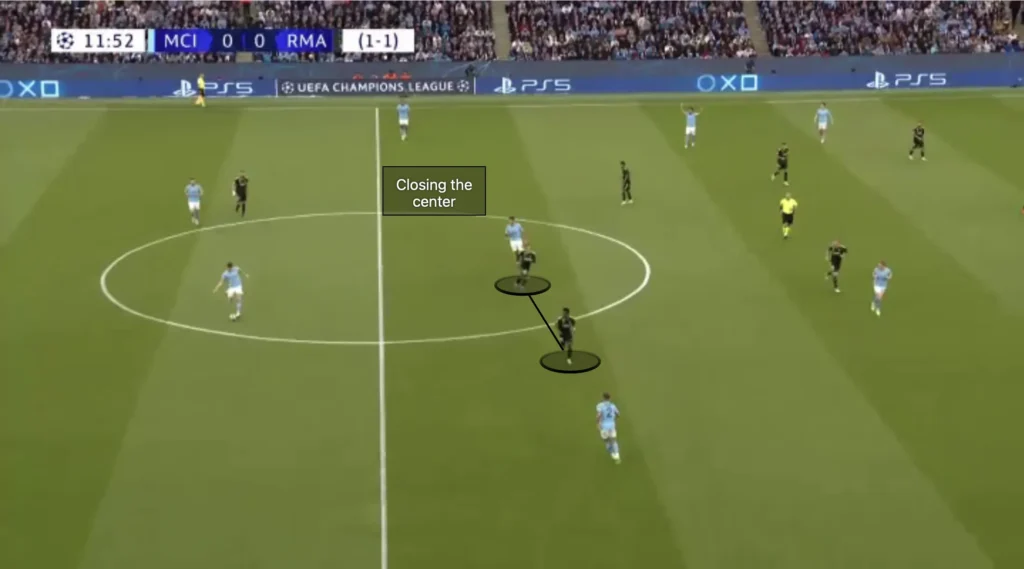
The ball-holder, John Stones, uses two bounce-passes, which pull the Madrid players apart, opening the space between them and allowing Stones to take the ball forward.
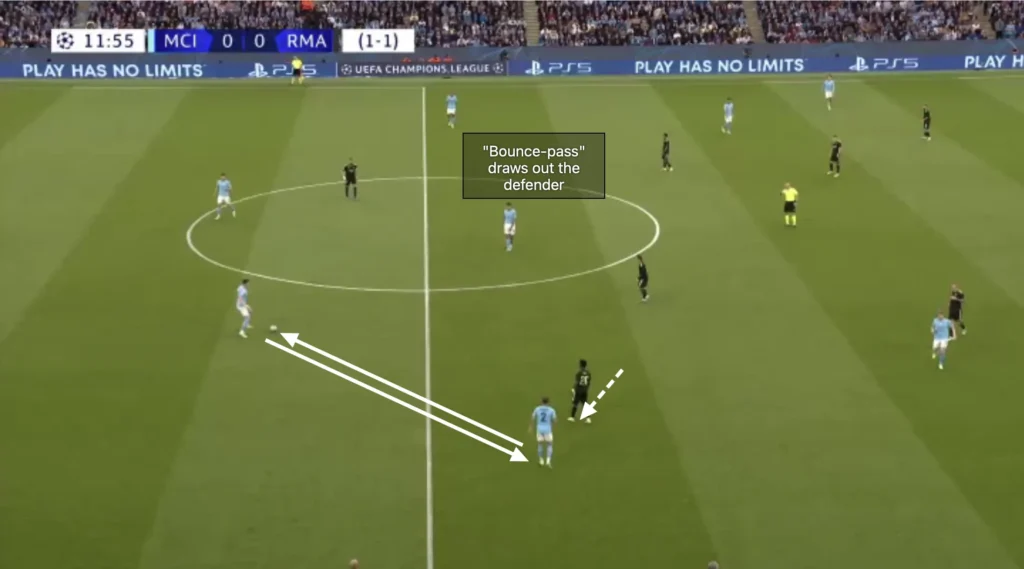
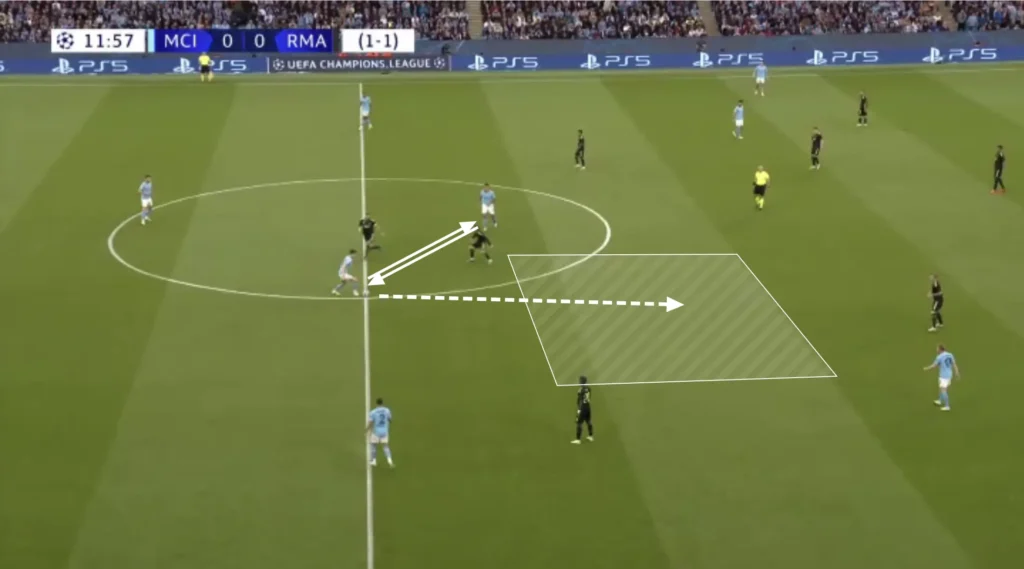
Numerical Advantages
Another massive aspect of Man City’s high build-up is their ability to create numerical advantages against the opposition’s defensive line. Their front five naturally becomes numerically superior against a back four, which they are great at taking advantage of.
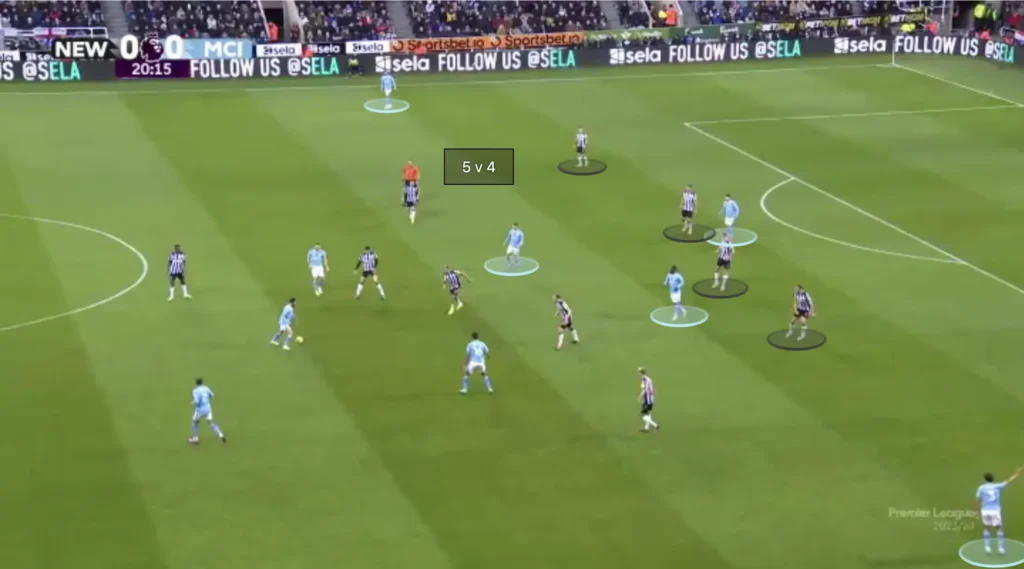
When the defending team is positioned on one side, the weak-side fullback becomes vulnerable to the long switch of play due to the 1v2 against Man City’s winger and attacking midfielder. Pep Guardiola’s team often capitalizes on this by getting the ball to the winger and creating many opportunities from 2v1 situations on the wing and in the half-spaces.
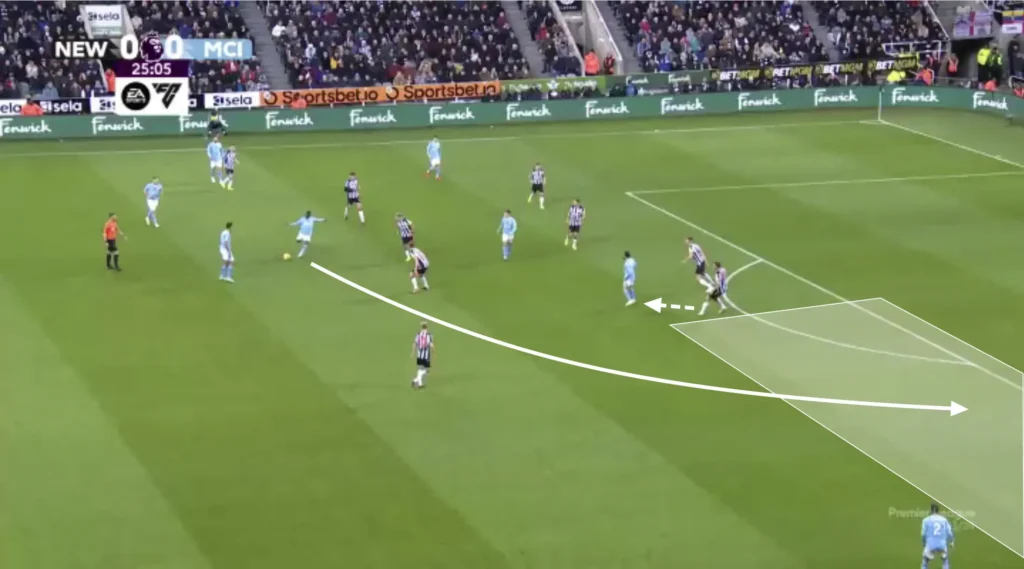
Defending
High Press
Pep Guardiola’s Manchester City presses the opposition high when possible and does so in a 1-4-1-3-2 formation:
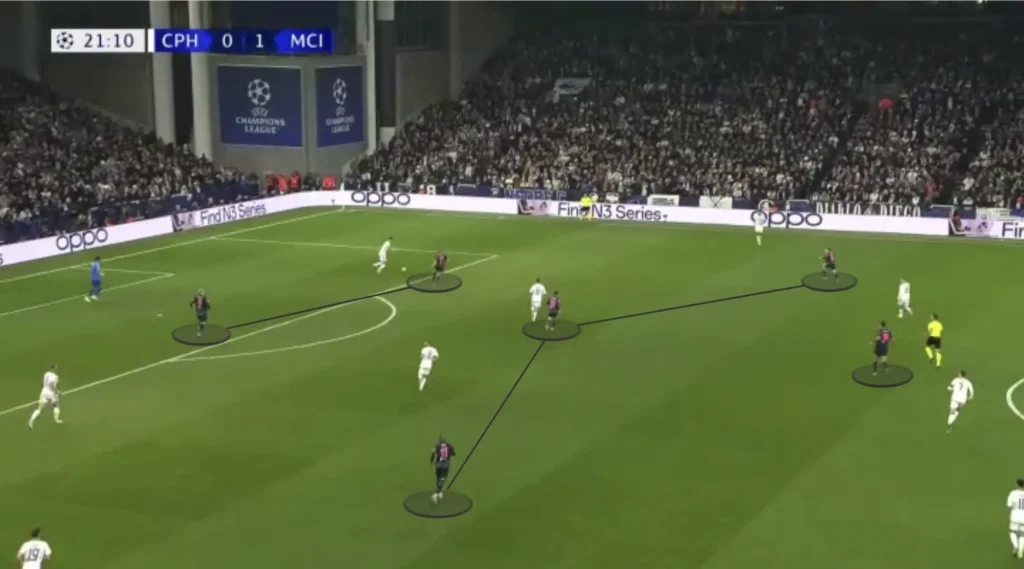
Many teams use a 1-4-3-3 formation in the build-up, which would give them a numerical advantage low down against Man City’s six midfielders and forwards. Guardiola solves this by leaving the opposition’s weak-side fullback open and going man-to-man on the rest of the players when the ball gets played to one of the sides. The ball-side wide-midfielder pressures the opposition ball-side fullback, the holding midfielder pushes over on the opposition ball-side number-eight, and the weak-side wide-midfielder tucks in to control the opposition weak-side number-eight.
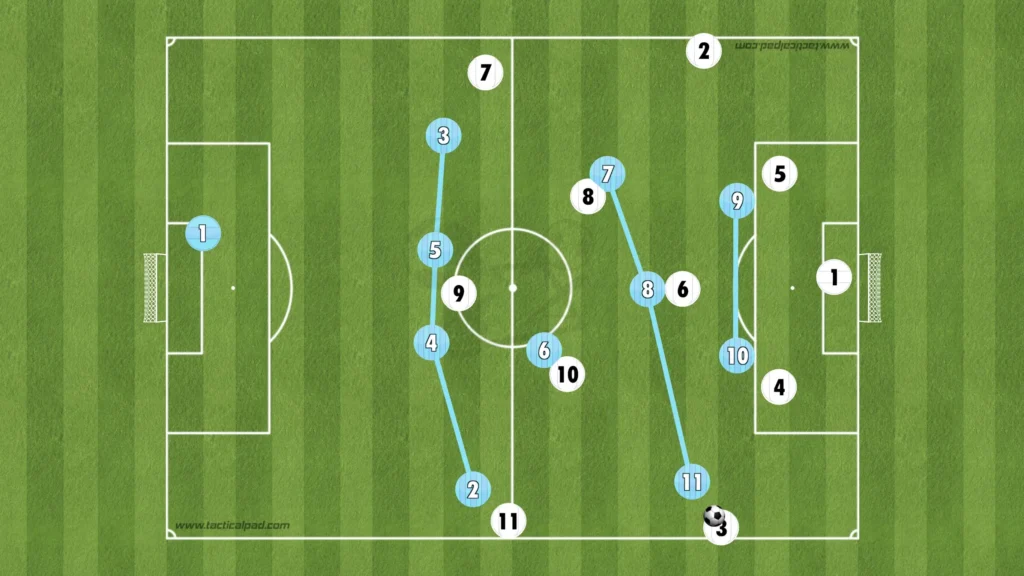
They can do this because the pass from one side to the other is too difficult for the ball-holder to make, and if he makes it, the Man City players have enough time to come across and win the ball. This system also gives City a numerical advantage against the opposition striker, giving them more control when defending long balls.
Low Press
In the low press, Pep Guardiola’s Man City uses a 1-4-4-2 formation. They look to set up in a mid-block, always trying to close the center, forcing the opposition out wide.
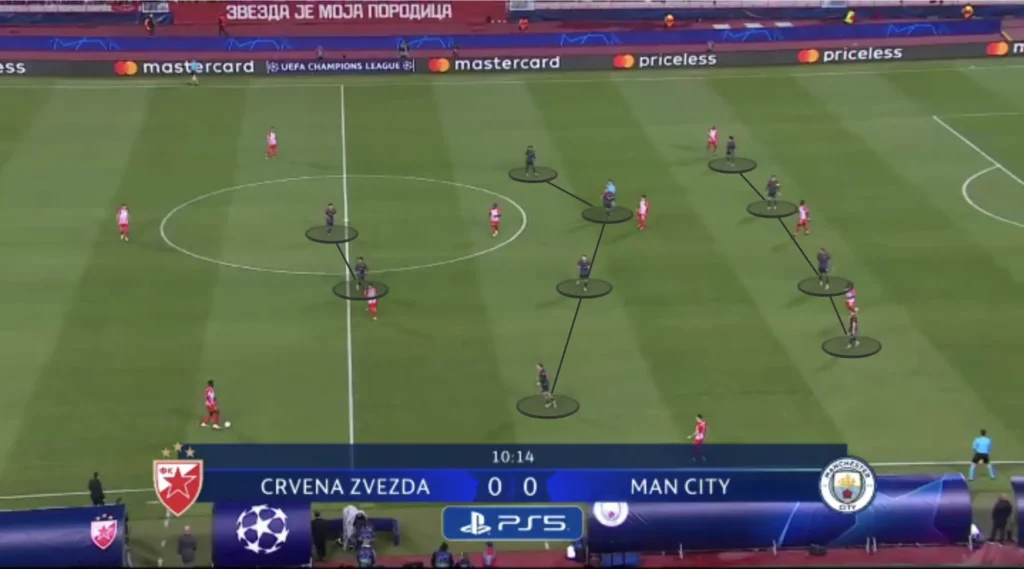
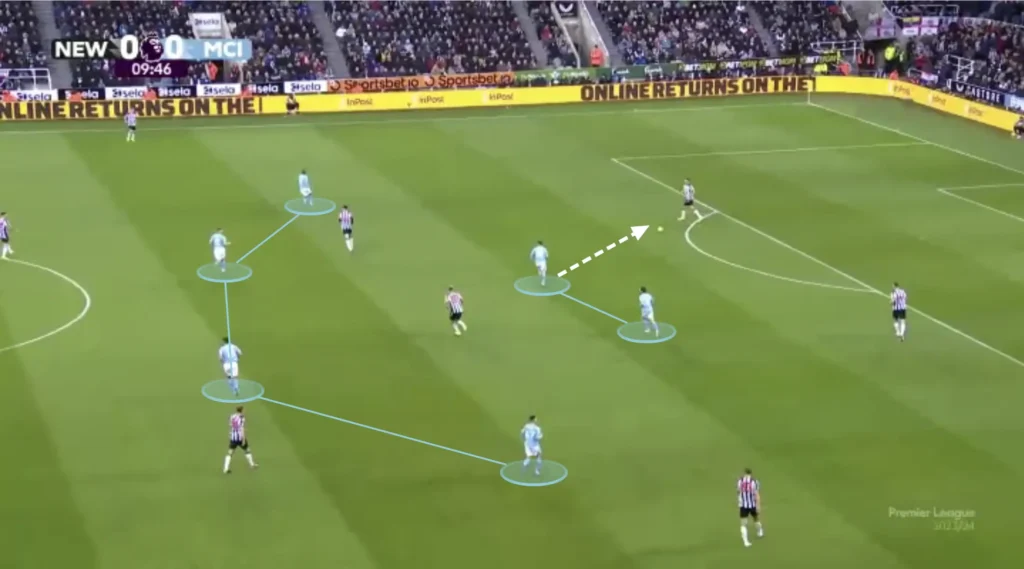
Man City look to squeeze the pitch when defending. This means constantly pushing the team up as much as possible. Every time the opponent plays a slow, sideways pass or a back pass, City’s first line of pressure pushes up, with the rest of the team following to stay compact. When the next pass comes, they push up even more, forcing the opponent back even more. They do this because it pushes the opponent further away from City’s goal, making it harder to create chances.
Defensive Transitions
Positioning many players centrally, creating a numerical advantage in the midfield, creates good conditions in defensive transitions. Many players close to the ball after losing possession means that many players can work towards regaining possession. Guardiola’s team, therefore, often regains possession directly after losing it. When they regain possession, they try to recycle the ball, not wanting to lose possession again.
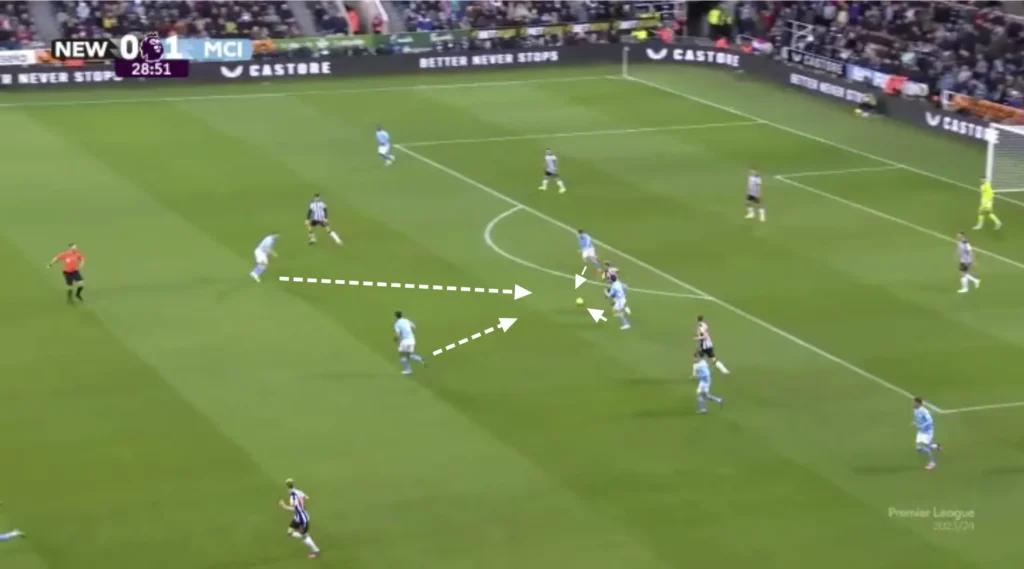
Final Thoughts
In conclusion, this tactical analysis of Pep Guardiola’s masterful strategies at Manchester City unveils the intricate details behind the club’s remarkable success. Guardiola’s unique approach, characterized by fluid formations, positional play, and innovative pressing, has left an immense mark on the global football landscape. From his meticulous build-up patterns to the relentless pressing schemes, this analysis provides a glimpse into the mind of a managerial maestro. As Pep Guardiola continues to redefine the tactical landscape, his impact on the beautiful game remains a fascinating study, showcasing the evolution of football under the guidance of a true visionary.
